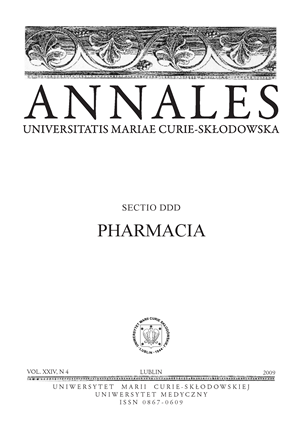Comparison of classic and modern methods of furocoumarinsextraction from Angelica officinalis Hoffm. and Pastinaca sativa L. fruits
Abstract
Simple extraction methods as macetarion, shaking, extraction, sonication-assistrd extraction (80%, 100%), homogenisation followed by sonication-assisted extraction were used to obtain coumarins from A. officinalis and P. sativa. The yield of coumarin extracted was compared by means of TLC and densitometry. The best results were obtained by means of modified ultrasound-assisted extraction: 1.8094 mg/g of xanthotoxin and 3.3109 mg/g sum of bergapten and imperatorin in Pastinaca sativa fruits and 2.2511 mg/g of xanthotoxin and 25.0069 mg/g sum of bergapten and imperatorin in Archangelica officinalis fruits.
References
1. Beier R., Oer t li E.: Psoralen and other linear furocoumarins as phytoalexins in celery. Phytochemistry, 22, 2595, 1983.
2. Glowniak K., Czuczwar S., Luszczki J.: Imperatorin enhances the protective activity of conventional antiepileptic drugs against maximal electroshock-induced seizures in mice Eur. J. Pharmacol., 574, 133, 2007.
3. Głowniak K.: Investigation and isolation of coumarine derivatives from polish plant material, Dissertation, Medical University, Lublin (Poland) 1988 (in Polish).
4. Johnstone R., Rose M.: Mass spectrometry for chemists and biochemists, PWN, Warszawa 2001, 105 (in Polish).
5. Łuszczki J., Glowniak K., Czuczwar J.: Time–course and dose–response relationships of imperatorinin the mouse maximal electroshock seizure threshold model Neurosci Res., 59, 18, 2007.
6. Mendonc C., Burden A.: Current concepts in psoriasis and its treatment Pharmacol. Ther., 99, 133, 2003.
7. Neumann N. et al.: Penetration Kinetics of 8-Methoxypsoralen after 8-Methoxypsoralen Bath Procedure with and without UVA Irradiation, Skin Pharmacol Appl. Skin. Physiol., 14, 210, 2001.
8. Ojala T.: Biological Screening of Plant Coumarins, Academic dissertation, University of Helsinki, Helsinki 2001.
9. Pokharel Y. at al.: Potent protective effect of isoimperatorin against aflatoxin B1-inducible cytotoxicity in H4IIE cells: bifunctional effects on glutathione S-transferase and CYP1A, Carcinogenesis, 27, 2483, 2006.
10. Salisova M., Toma S., Ma son T.: Comparison of conventional and ultrasonically assisted extractions of pharmaceutically active compounds from Salvia officinalis. Ultrasonics, Sonochemistry, 4, 131, 1997.
11. Serrano-Perez J. et al.: The family of furocoumarins: Looking for the best photosensitizer for phototherapy. Journal of Photochem. Photobiol. Chemistry, 199, 34, 2008.
12. Siddiqui A., Stolk L., Cormane R.: Comparison of serum levels and clinical results of PUVA therapy with three different dosage forms of 8-methoxypsoralen, Arch. Dermatol. Res., 5, 343, 1984.
13. Vinatoru M. et al.: The use of ultrasound for the extraction of bioactive principles from plant materials. Ultrasonics, Sonochemistry, 4, 135, 1997.
14. Waksmundzka-Hajnos M. et al.: Thin Layer Chromatography in Phytochemistry. CRC Press Taylor & Francis Group, NW, 365, 2007.
15. Waksmundzka-Hajnos M., Petruczynik A., Dragan A.: Influence of the extraction mode on the yield of some furanocoumarins from Pastinaca sativa fruits. J. Chromatogr. B, 800, 181, 2004.
16. Wang L., Weller C.: Recent advances in extraction of nutraceuticals from plants, Trends Food Sci. Technol., 17, 300, 2006.
Downloads
Published
Issue
Section
License
Copyright (c) 2009 Authors

This work is licensed under a Creative Commons Attribution-NonCommercial-NoDerivatives 3.0 Unported License.


